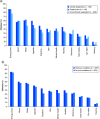Clinical characteristics, activity levels and mental health problems in children with long coronavirus disease: a survey of 510 children
- PMID: 35360923
- PMCID: PMC9248023
- DOI: 10.2217/fmb-2021-0285
Clinical characteristics, activity levels and mental health problems in children with long coronavirus disease: a survey of 510 children
Abstract
Background: Whether long coronavirus disease pertains to children as well is not yet clear. Methods: The authors performed a survey in children suffering from persistent symptoms since initial infection. A total of 510 children infected between January 2020 and January 2021 were included. Results: Symptoms such as fatigue, headache, muscle and joint pain, rashes and heart palpitations and issues such as lack of concentration and short-term memory problems were particularly frequent and confirm previous observations, suggesting that they may characterize this condition. Conclusion: A better comprehension of long coronavirus disease is urgently needed.
Keywords: children; long COVID; neuropsychiatric symptoms; prolonged symptoms; survey.
Figures



References
-
- Carfì A, Bernabei R, Landi F et al. Persistent symptoms in patients after acute COVID-19. JAMA 324(6), 603–605 (2020). - PMC - PubMed
-
•• Italian researchers first documented that a relevant percentage of patients with coronavirus disease 2019 (COVID-19) experience persistent symptoms after resolution of acute disease.
MeSH terms
LinkOut - more resources
Full Text Sources
Medical
